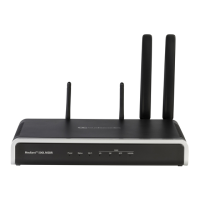User's Manual 648 Document #: LTRT-10466
Mediant 500L MSBR
10.31.4.75. TFTP is assumed to be on the same computer as the DHCP server
(alternatively, the "next-server" directive may be used).
ddns-update-style ad-hoc;
default-lease-time 60;
max-lease-time 60;
class "gateways" {
match if(substring(hardware, 1, 3) = 00:90:8f);
}
subnet 10.31.0.0 netmask 255.255.0.0 {
pool {
allow members of "audiocodes";
range 10.31.4.53 10.31.4.75;
filename "SIP_F6.60A.217.003.cmp –fb;device.ini";
option routers 10.31.0.1;
option subnet-mask 255.255.0.0;
}
}
Notes:
• If, during operation, the device's IP address is changed as a result of a DHCP
renewal, the device automatically resets.
• If the DHCP server denies the use of the device's current IP address and specifies
a different IP address (according to RFC 1541), the device must change its
networking parameters. If this occurs while calls are in progress, they are not
automatically rerouted to the new network address. Therefore, administrators are
advised to configure DHCP servers to allow renewal of IP addresses.
• If the device's network cable is disconnected and then reconnected, a DHCP
renewal is performed (to verify that the device is still connected to the same
network). The device also includes its product name in the DHCP Option 60
Vendor Class Identifier. The DHCP server can use this product name to assign an
IP address accordingly.
• After power-up, the device performs two distinct DHCP sequences. Only in the
second sequence is DHCP Option 60 included. If the device is software reset
(e.g., from the Web interface or SNMP), only a single DHCP sequence containing
Option 60 is sent.
47.1.2 HTTP-based Provisioning
An HTTP or HTTPS server can be located in the network in which the device is deployed,
storing configuration and software files for the device to download. This does not require
additional servers and is NAT-safe.
For example, assume the core network HTTPS server is https://www.corp.com. A master
configuration ini file can be stored on the server, e.g.,
https://www.corp.com/gateways/master.ini. This file could point to additional ini files,
auxiliary files (e.g., call progress tones), and software files (cmp), all on the same HTTP
server or different HTTP servers in the network.
The main advantage of this method is that the device can be configured to periodically
check the HTTP server for file updates. HTTP(S) is not sensitive to NAT devices, enabling
configuration whenever needed without on-site intervention. For additional security, the
URL may contain a different port, and username and password.
The only configuration required is to preconfigure the device(s) with the URL of the initial
(master) ini file. This can be done using one of the following methods:
DHCP as described in ''DHCP-based Provisioning'' on page 647 or via TFTP at a
staging warehouse. The URL is configured using the IniFileURL parameter.

